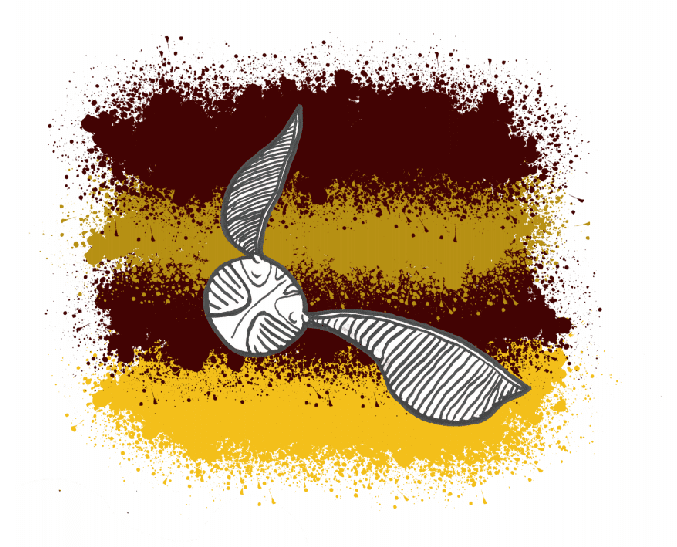Upon mentioning quidditch to the uninitiated, there are two questions that a player always receives. The first is, “wait, do you fly?”, and this is easily answered: “No. Sorry”. The second is, “so then – how does the Snitch work?” This, I will explain in due course, for there is much more about the game that must be explained first.
Quidditch is a full-contact, mixed-gender sport. What does that really mean? It means that women, men, and everyone in between play on the field together. Gender inclusivity is literally written into the rulebook: no more than four players (on a team of seven) of the same gender may be on the field at once. These players may play one of three positions: Chaser/Keeper, Beater and Seeker.
Chasers and Keepers have a very simple goal: put the quaffle (a volleyball) through the opposition’s hoops, and stop the other team from doing the same to them. The ‘quaffle game’ might be likened to basketball or rugby, and each goal is worth 10 points. There are three chasers and one keeper in a ‘quaffle team.’
Beaters, unlike Fred and George, do not hold bats – instead, they hold bludgers (dodgeballs) that they can throw at any member of the opposition (just like dodgeball). Getting hit with a bludger is called getting ‘beat’ and knocks you out of play until you can run back, touch your defensive hoops and re-enter play.
Seekers, again, play an entirely different game. The tiny, shiny, Golden Snitch from the books is represented in real life by an oz-tag style tag on the back of the shorts of a Snitch Runner who really, really doesn’t want you to pull it off them. The Seekers have the unenviable job of running to and fro across the pitch after the Snitch Runner, and once they catch up, they must then wrestle the Snitch Runner to pull off the tag, earn 30 points for their team, and end the game.
And just in case that wasn’t enough confusion, quidditch also incorporates a handicap. In basketball, you must bounce the ball. In soccer, you can’t touch it with your hands. In quidditch, you must have a stick (PVC pipe or wooden dowel, not an actual broomstick) between your legs at all times. In addition to looking a wee bit silly, it throws in the twist of making the already complicated game now, essentially, one-handed.
I wouldn’t be surprised if you’re now asking yourself why on earth anyone would play such a complicated, confusing game. However, the chaos of quidditch is in many ways its primary attraction – it’s simply FUN. In a game where you’re running around with a stick between your legs and balls are flying everywhere, it’s impossible to not smile. That being said, the sport isn’t rapidly growing by merit of its ridiculousness alone. Many female players leap at the opportunity to play quidditch simply because it’s mixed gender and full contact – in what other sport is a woman going to have the opportunity to square off with a male as an equal? While feminism continues to rise and women are gradually being offered more opportunities in the world, sports at large are lagging behind the trend, with segregation of both play and pay still prevalent. Quidditch provides an opportunity for people of all genders to come together and make a difference on the pitch. I really do mean it when I say that the largest, strongest man and the smallest, daintiest girl (or the other way around) may be equally as effective on pitch. Quidditch is a sport that, due to all its complexity and chaos, rewards a good thinker just as much as it rewards physical prowess.
“So then, what about Harry Potter?” you say. Well, he’s not really in the picture anymore. Quidditch has rapidly matured away from the glorified roleplay it originated as in 2005. People who first hear about quidditch may mock its players as ‘a bunch of book nerds’ but will very quickly retract the statement after watching a match. However, the essence of the world and the sport that Rowling dreamed up still remains; for so many of our generation, the world of Harry Potter and quidditch represents a safe space where individuals and groups have the opportunity to prove themselves despite adversity. That has certainly been my personal experience as a quidditch player; while I discovered my own drive, fitness and enthusiasm for the game, and formed friendships and team bonds, the ANU Owls team has progressed up the ranks, rising to the top of the NSW state league.
Not only is there league-level play; Quidditch Australia annually hosts a State Shield competition (akin to NRL’s State of Origin) where the best from each state face off to play the highest-level quidditch in Australia. Last year, seven members of the ANU team were involved in the NSW state representative team. And yes, there is even a World Cup for quidditch, just like in the books. It’s held biennially, and in 2016 James Mortensen, ANU’s coach, captained the Australian team to victory in Frankfurt, Germany. This year the World Cup is being held in Florence, Italy, and one of ANU’s long-time members, Danny Fox, is leading the team as assistant coach. While quidditch on a global scale is accessible for any player to pursue, the game still comfortably accommodates everybody: competitive or not, big or small, athletic or slow, thinkers and doers alike.
We acknowledge the Ngunnawal and Ngambri people, who are the Traditional Custodians of the land on which Woroni, Woroni Radio and Woroni TV are created, edited, published, printed and distributed. We pay our respects to Elders past and present. We acknowledge that the name Woroni was taken from the Wadi Wadi Nation without permission, and we are striving to do better for future reconciliation.
